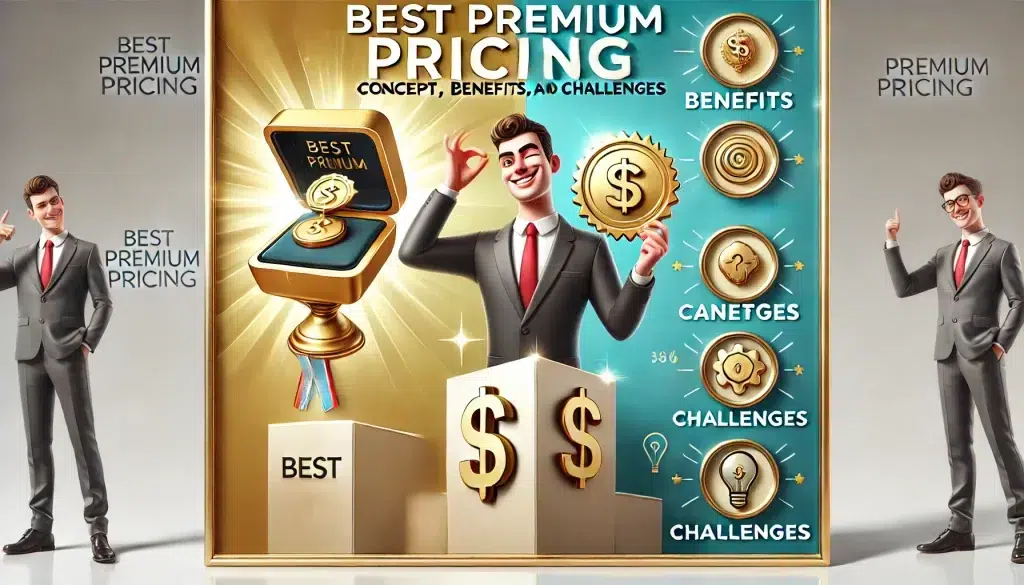
In the e-commerce sector, while low prices drive some customers, others seek exclusivity and superior quality. This desire for unique, high-quality products allows businesses to strategically adopt premium pricing strategies.
Premium pricing, or prestige pricing, involves setting prices significantly higher than the market average to create a perception of superior value and exclusivity.
This approach enhances the brand’s image and attracts a specific segment of consumers willing to pay more for exceptional products.
By leveraging premium pricing, companies can differentiate themselves from competitors and build a loyal customer base that values quality over cost.
According to a study by Bain & Company, brands implementing premium pricing can achieve higher profit margins and foster stronger customer loyalty.
Let’s have a detailed look at what Premium Pricing is, its pros and cons, and when it makes sense.
What Is The Concept of Premium Pricing?
Premium pricing, or prestige pricing, involves setting product prices significantly above the market average to leverage a product’s perceived value and exclusivity, enhancing its appeal as a luxury item.
Let’s detail how this pricing strategy impacts consumer perceptions through factors like high-quality perception and exclusivity associated with premium-priced products.
Perception of Quality and Exclusivity
Products with premium prices are often perceived as higher quality due to superior materials, craftsmanship, or technology.
For instance, luxury brands like Rolex and Ferrari charge higher prices as their products are seen as the epitome of fine materials and cutting-edge innovation.
High prices create a sense of exclusivity and status. Owning premium-priced products often signals wealth and prestige.
Brands like Gucci and Louis Vuitton leverage this by ensuring their products are not just commodities but status symbols.
Target Market
Premium pricing targets affluent consumers who are less sensitive to price changes and more focused on product quality, brand reputation, and exclusivity.
This strategy is effective in niche markets where unique, high-quality products are valued over mass-market alternatives.
For example, Tesla targets environmentally conscious consumers looking for high-performance electric vehicles.
Brand Image and Positioning
Luxury Branding: Premium pricing helps build and maintain a luxury brand image. This requires consistent marketing efforts highlighting the products’ exclusivity, quality, and unique value proposition.
High prices can enhance brand loyalty as consumers develop a sense of pride and attachment to the brand. They are more likely to repeat purchases and recommend the brand to others.
Psychological Pricing
Consumers often use price as an indicator of quality. This is a concept known as ‘psychological pricing ‘. Higher prices suggest better quality and more reliable products. Luxury brands utilize this psychological effect to justify their premium pricing.
Limited edition products or those with limited availability often attract premium prices. The scarcity creates higher demand among consumers eager to own something unique and exclusive.
Implementation Strategies
Companies using premium pricing ensure their products stand out in design, features, and overall experience. Apple, for example, differentiates its iPhones through innovative features, design aesthetics, and a seamless ecosystem.
Significant investments in marketing and promotion are necessary to maintain the luxurious image. Brands often use high-profile endorsements, exclusive events, and sophisticated advertising to reinforce their premium positioning.
Premium pricing is a strategic approach that goes beyond setting high prices. It involves creating a holistic perception of superior value, exclusivity, and luxury, which appeals to a specific segment of the market willing to pay a premium for these attributes. Brands like Apple, Rolex, and Gucci have successfully employed this strategy, building strong brand identities and loyal customer bases.
What Are Ideal Situations for Premium Pricing?
Premium pricing strategically sets product prices significantly above the market average, leveraging the perceived value and uniqueness of the product.
This pricing strategy is most effective under specific conditions that elevate a product’s perceived worth and exclusivity in consumers’ eyes.
1. Established High-Quality Brand
When a brand is recognized for its high-quality and exclusive products, it is ideally positioned to adopt premium pricing. Consumers familiar with the brand’s heritage are more likely to view the high price as a reflection of quality and exclusivity.
This scenario is common among luxury fashion and technology brands that have established a strong brand identity over the years.
Their commitment to excellence in product quality and consumer experience allows them to command higher prices.
2. Unique Market Entry
Launching a product in a market without direct competitors can also justify a higher price setting. In such cases, the novelty and uniqueness of the product provide a strong value proposition.
This approach is advantageous for technological innovations or specialty products in niche markets. For instance, when Apple launched the first iPhone, it was a unique market entry with no direct competitors, allowing them to set a higher price.
The lack of alternatives made the product more appealing, and consumers were willing to pay a premium to access new and unique features or benefits.
By understanding when and where this pricing strategy can be most effectively implemented, businesses can better position themselves to capture and sustain higher profit margins.
The Advantages of Implementing Premium Pricing
Exploring the benefits of premium pricing reveals how strategic price setting can significantly enhance a brand’s profitability and perceived market value.
1. Increased Profit Margins: Brands can achieve greater profit margins per sale by setting higher prices. This is effective even with lower sales volumes, as the higher price per unit compensates for fewer transactions. Apple is a prime example, where the brand’s high-priced products continue to secure substantial profits due to their perceived value and innovation.
2. Enhanced Brand Value: Premium pricing can elevate a brand’s perceived value in the market. Consumers often associate higher prices with superior quality and exclusivity, strengthening brand prestige and loyalty. This strategy attracts consumers who value quality over cost and enhances the brand image.
The Challenges of Premium Pricing
While premium pricing can offer significant advantages, it also presents unique challenges that require careful management.
1. High Marketing Costs: Sustaining a premium brand image requires significant investment in marketing and advertising. High-end brands like Nike and Adidas spend millions annually, reinforcing their premium positioning. This includes advertising campaigns, celebrity endorsements, and high-profile events that align with the luxurious image they project.
2. Consistency in Brand Storytelling: Premium brands must maintain a consistent brand story across all platforms. This means ensuring that every touchpoint—from product packaging and descriptions to blog posts and social media content—communicates luxury and exclusivity. Transparency in sourcing materials, ethical practices, and community contributions can further enhance a brand’s prestige, making the narrative more relatable and improving consumer trust.
How to Craft Your Brand Story for Premium Pricing
Crafting a compelling brand story for premium pricing involves strategic communication and consistency to elevate your products’ perceived value and uniqueness. This strategy helps justify the higher price point through storytelling that connects with consumers emotionally.
1. Highlight Product Differentiation
Emphasizing what sets your product apart is crucial. For instance, if you’re selling a bottle of water for $4, it’s essential to clarify why it’s worth more than a standard $1 bottle. This could be due to unique sourcing, added health benefits, or a luxurious packaging design. You create a perceived value that aligns with the premium price by clearly articulating these distinctive features.
2. Show, Don’t Tell
Rather than just telling customers about the quality of your products, show them through vivid storytelling, immersive experiences, and engaging content. This approach can include customer testimonials, behind-the-scenes videos, or interactive online experiences that convey the passion and craftsmanship behind your brand.
The goal is to evoke emotions and create a sensory perception of luxury and exclusivity.
3. Be Transparent
Transparency is increasingly important to consumers, especially in the premium market. Openly sharing information about your business practices, such as ethical sourcing, sustainable manufacturing, or support for local communities, can build trust and reinforce the value of your brand.
This transparency attracts informed consumers and fosters loyalty by aligning your brand’s values with your customers.
4. Maintain Consistency
Consistency across all communication channels ensures that your brand story remains cohesive and reinforces your premium image. This means maintaining the same tone, style, and messaging on your website, social media, packaging, or advertising. Consistent storytelling helps build a strong, recognizable brand identity that consumers associate with quality and reliability.
By integrating these elements into your branding strategy, you can effectively position your products at a premium price point, attracting consumers willing to pay more for exceptional products.
What is the difference between premium pricing and value-based pricing?
Premium pricing focuses on setting prices higher than competitors based on perceived quality or prestige, while value-based pricing considers the value that customers derive from a product or service to determine pricing.
How can companies justify a premium price to customers?
Companies can justify a premium price by highlighting the superior quality, innovative features, exclusive benefits, or exceptional customer service that their offerings provide compared to competitors.
FAQs
What are some examples of companies that successfully implement a premium pricing strategy?
Luxury brands such as Rolex, Apple, and Mercedes-Benz are examples of companies that successfully implement a premium pricing strategy by offering high-quality, innovative products with a strong brand image.
Is premium pricing strategy suitable for all types of products or services?
Premium pricing strategy is most effective for products or services that offer unique features, superior quality, exclusivity, or prestige that justify a higher price point and appeal to a target market willing to pay a premium.
How can companies adapt their premium pricing strategy to changing market conditions?
Companies can adapt their premium pricing strategy to changing market conditions by conducting regular market research, monitoring customer feedback, and adjusting pricing, features, or marketing strategies to stay competitive and meet customer needs.
What are the potential risks of implementing a premium pricing strategy?
The potential risks of implementing a premium pricing strategy include alienating price-sensitive customers, facing competition from lower-priced alternatives, and damaging brand reputation if the perceived value does not align with the premium price.
Conclusion
Before implementing a premium pricing strategy, it is essential to assess whether your product and business model are robust enough to support higher pricing.
Successfully applying this strategy requires that your products’ intrinsic value and uniqueness are communicated to and perceived by your target market.
This involves ensuring product quality that aligns with premium pricing and meticulously crafting your brand’s narrative to highlight the exclusivity and luxury associated with your offerings.
Ultimately, the goal is to align your pricing strategy with consumer expectations and market demand to secure and sustain customer loyalty and higher profit margins.




